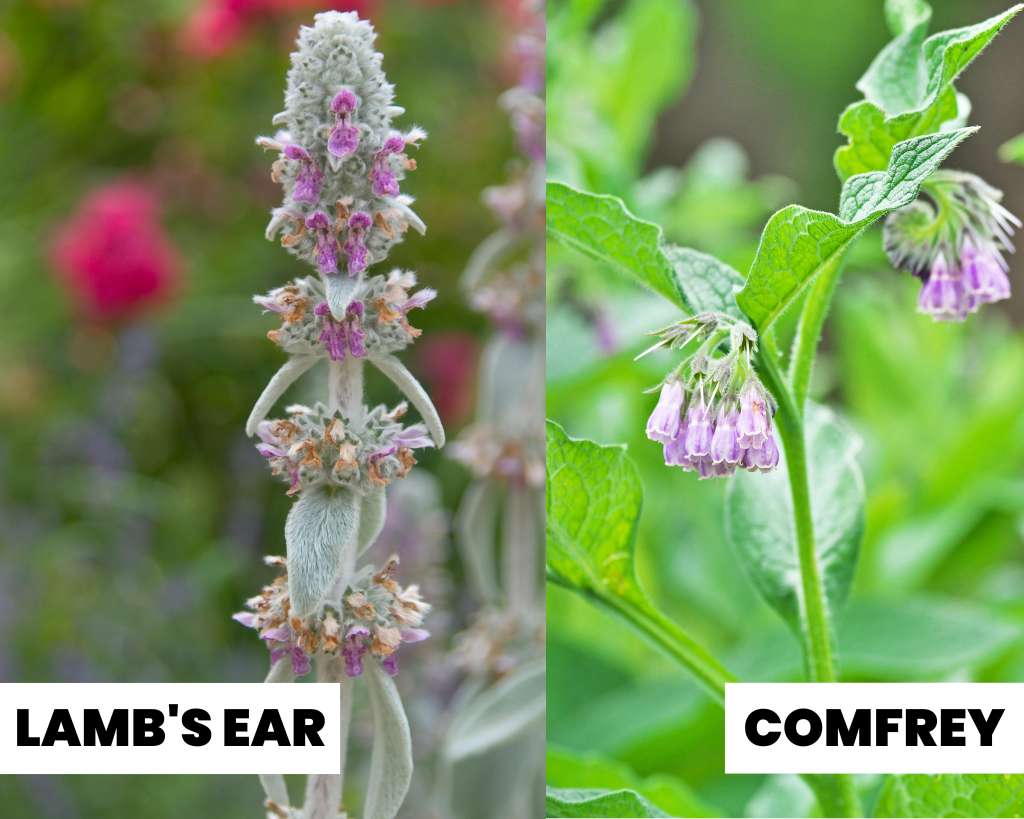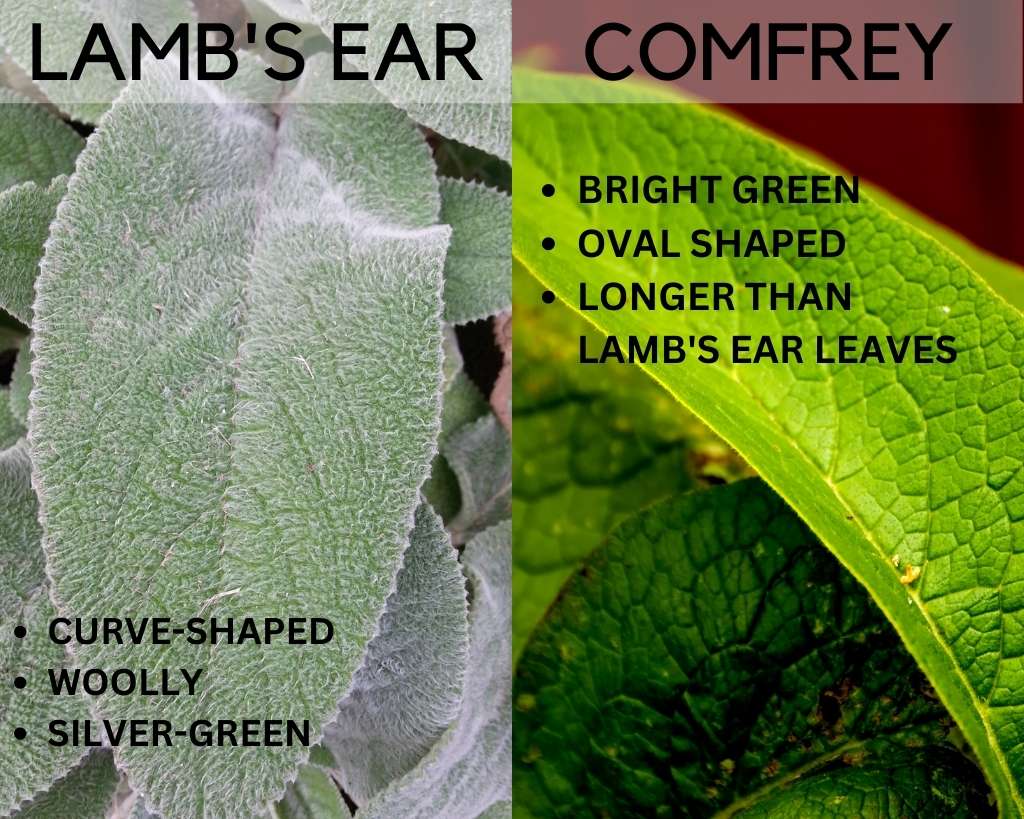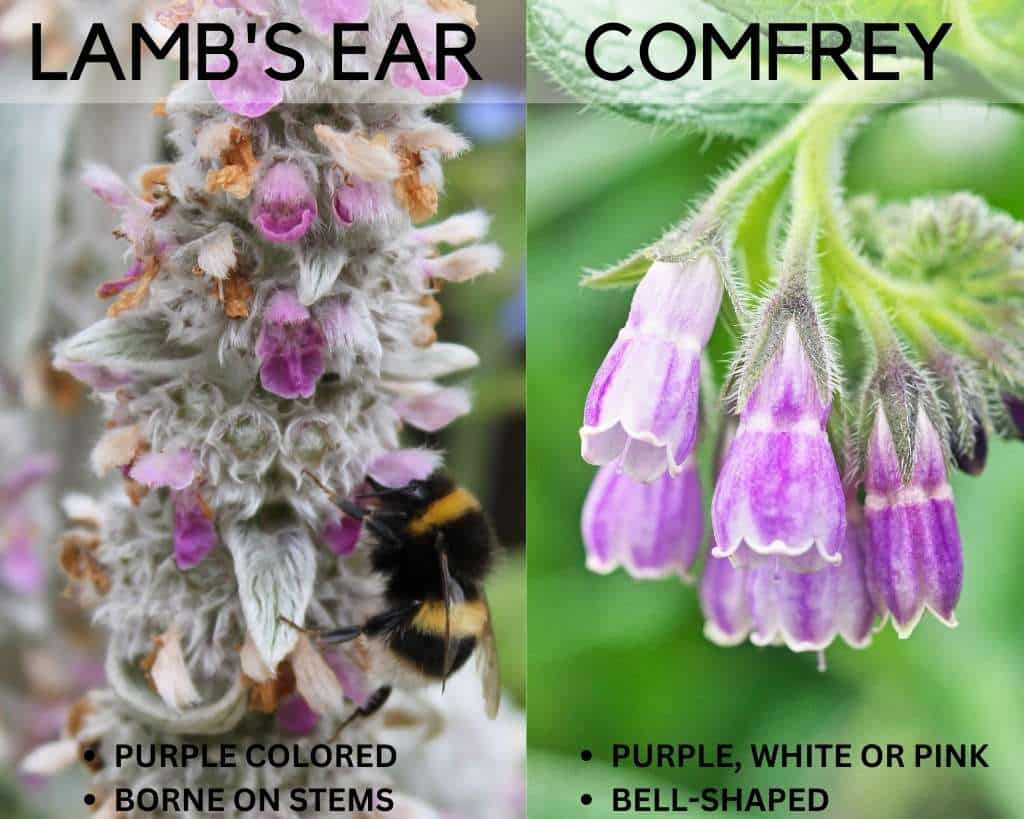Lamb’s Ear has curve-shaped, woolly textured, silver-gray leaves. The leaves are 4 inches long and can grow longer in favorable climatic conditions. Comfrey has bright green hairy leaves that are oval or lance-shaped and are about 6 inches long. They are attached to the stem by a short petiole and are produced in an alternate arrangement on the stem.
| Lamb’s Ear | Comfrey | |
| Name | Stachys byzantina | Symphytum spp. |
| Zones | 4-9 | 4-9 |
| Height | 1-2 feet (30-60 cm) | 3-4 feet (90-120 cm) |
| Width | 1-2 feet (30-60 cm) | 2-3 feet (60-90 cm) |
| Sunlight | Full sun to partial shade | Full sun to full shade |
| Soil | Well-Drained | Well-Drained |
| Lifespan | Perennial | Perennial |
| Origin | Middle-East | Europe, Asia |
| Family | Lamiaceae | Boraginaceae |
| Propagation | Seeds, Division | root cuttings, division, or seed |
| Diseases | powdery mildew and rust | Comfrey rust, powdery mildew |
| Pests | slugs and snails | slugs and snails |

Lamb’s Ear vs Comfrey – Key Differences
We will discuss some key points regarding Lamb’s Ear vs Comfrey which will help you decide the plant you will be growing for your landscape garden.
Plant Size
Most Lamb’s Ear plant varieties can reach up to 1-2 feet in height. It can spread up to 1-2 feet. Poor sunlight can result in decreased plant growth. Plants grow in clumps that form mounded masses of foliage.
Comfrey is generally taller than Lamb’s Ear. It can easily reach up to 3-4 ft in height and spread up to 2-4 ft wide.
Stems

Lamb’s Ear stem is silver-gray or green-gray, depending upon the variety. It is typically upright with a woolly texture covered with hair. The stems are thinner and more flexible than the stems of Comfrey.
Comfrey has small, bell-shaped flowers that are borne in clusters at the ends of the stems, while lamb’s Ear has small, pink or purple flowers that are produced on tall stems that arise from the base of the plant.
Leaves – color, shape, size, and texture

Lamb’s Ear has curve-shaped, woolly textured, silver-gray leaves. The leaves are 4 inches long and can grow longer in favorable climatic conditions. Comfrey has bright green hairy leaves that are oval or lance-shaped and are about 6 inches long. They are attached to the stem by a short petiole and are produced in an alternate arrangement on the stem.
Flowers

Lamb’s Ear has small, pink or purple flowers borne on tall stems, while Comfrey has small, bell-shaped flowers borne in clusters at the ends of the stems.
Lamb’s Ear flowers are typically pink or purple, while comfrey flowers can be purple, white, or pink.
Additionally, the flowers of lamb’s Ear are not particularly showy, while the flowers of Comfrey are more noticeable due to their clusters of bright colors. Insects pollinate the flowers of both lamb’s Ear and Comfrey, and the plants produce seeds which can be used for propagation.
Also Read: Lamb’s Ear vs Mullein: Which is Better for Your Garden?
Benefits
Lamb’s Ear is a well-known groundcover, drought-tolerant plant that can survive with minimal watering, making it a good choice for dry environments. Lamb’s Ear requires little care and is easy to grow. It is resistant to pests and diseases. It can attract butterflies and other pollinators to the garden, making it a good choice for those interested in attracting wildlife.
Comfrey has been traditionally used to treat wounds and skin irritation due to its high mucilage content. Comfrey contains compounds known as allantoin, which are believed to stimulate the growth of new cells and help promote bone healing. It is used as a natural fertilizer due to its high levels of nitrogen, potassium, and other nutrients.
Drawbacks
Both Lamb’s Ear and Comfrey have the potential to spread rapidly and become invasive in some areas. Comfrey contains certain toxic compounds, including pyrrolizidine alkaloids, which can cause liver damage if ingested in large amounts.
Lamb’s Ear and Comfrey are relatively resistant to pests and diseases but are not immune.
Is it possible to grow Lamb’s Ear & Comfrey together?
Yes, lamb’s Ear (Stachys byzantina) and Comfrey (Symphytum spp.) can be grown together in the same garden bed. Both plants are hardy and can tolerate a wide range of growing conditions.
Also Read: 8 Lamb’s Ear Companion Plants To Transform Your Garden
How long do these plants last?
Lamb’s Ear and Comfrey are perennial plants that can thrive for many years with proper care. Lamb’s Ear can live for several years, although it may die back in cold winters and reappear in the spring.
Comfrey is also a perennial plant; it can live for up to 20 years or more with proper care. Both plants are known for tolerating a wide range of growing conditions, including drought, and can be grown in various soil types.
To help them thrive and maximize their lifespan, it is important to provide them with adequate sunlight, water, and nutrients and protect them from pests and diseases.




[…] Also Read: Lamb’s Ear vs Comfrey: A Head-to-Head Comparison […]